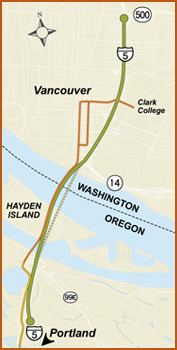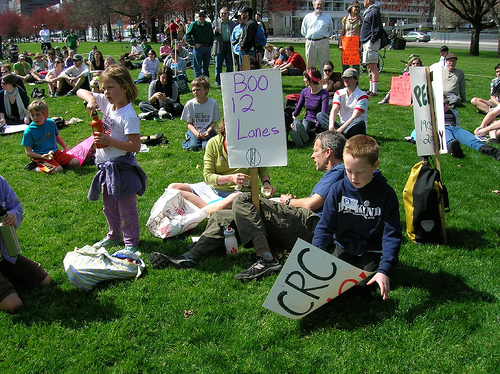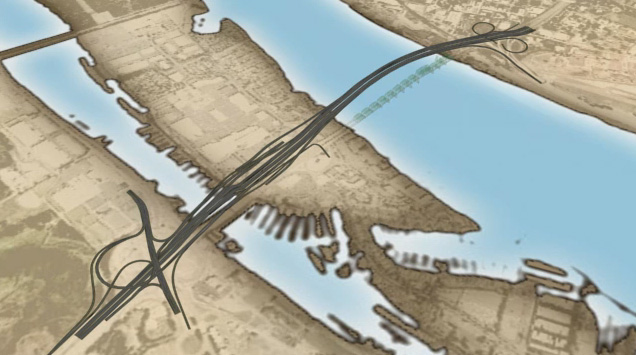The Columbia River Crossing: A Highway Boondoggle in Disguise
12:51 PM EDT on April 14, 2011
The Columbia River Crossing is a mega-project by any standard. A bridge replacement, a highway widening, and light rail project wrapped into one, the CRC is a proposal to span the distance between Portland, Oregon and Vancouver, Washington. With a $3.2 billion price tag -- by conservative estimates -- it would be the largest public works project the region has ever undertaken.
Any project of the CRC's transformative scope raises a great many questions. For starters, is it worth the investment? Can the region afford it? Will it promote a healthy environment? Will it induce sprawl?
In the five years since project engineers began honing their plan, more and more local observers have become adamant that it fails on all counts. "It’s a disaster of a project, really," said Jonathan Maus of Bike Portland. "It just doesn’t make any sense." But while governors are killing worthy transit and rail projects left and right, this fantastically expensive sprawl generator still has a pulse.

Planning efforts alone for the Columbia River Crossing have thus far consumed $110 million. After all that expense and all those meetings, local observers say there's still little agreement about what form it should take -- or whether it should move forward at all.
The project is intended to reduce congestion on Interstate 5 between Portland and suburban Vancouver, which, officials say, backs up for six hours daily. Their plan is to expand the interstate from six to 10 lanes, demolish the existing drawbridge and build a replacement.
But $3+ billion is a lot of money to spend on a five-mile stretch of roadway, particularly when the Portland region is facing a $6 billion road budget shortfall by 2030. And at least one analysis has said the actual fiscal damage could be a lot worse.
Financial questions aside, the project runs contrary to the values of sustainability and walkability on which Portland has built its reputation, says David Osborn of the grassroots opposition group Stop the CRC. According to Osborn, the CRC typifies the kind of single-occupancy-vehicle infrastructure that the region has expressly rejected.
"We’re known for and really value alternative transportation," Osborn said. "That’s the kind of transportation solutions that our region is looking for -- transportation infrastructure that favors small, walkable communities. Building freeways doesn’t create that kind of community."
Earlier this year, Stop the CRC held a poster contest and invited the public to take part. A month prior to that, local activist Spencer Boomhower produced a powerful video arguing that the project is wasteful and ill-conceived.
Opponents point out that the majority of the cost is dedicated to increasing car capacity on I-5. Of the total cost, only about $800 million would be used for the bridge replacement, with another $600 million going to light rail. Much of the remaining $1.8 billion would be spent expanding interchanges.
"This is a freeway expansion project," said Osborn. "It is often kind of guised as a bridge."
And many recognize the CRC for what it is. The original plan was for expanding I-5 to 12 lanes, but planners pared it back following public outcry. Local bike advocates aren't sold on it, even though the project is slated to include bike and pedestrian facilities under the new bridge. The regional Bicycle Transportation Alliance withdrew its support two years ago, accusing sponsors of "vastly overstating" the benefit to bicyclists and pedestrians.

Commissioners from Clark County refused to vote in favor of the design, despite the urging of supporters. The local paper summarized one commissioner's position as such: You leave us out of this.
Maus is convinced the project will never see the light of day. "It’s so politically toxic," he said. "There’s just no money for it and it’s too controversial."
But Osborn is not as sanguine. After all, in his budget announcement last month, President Obama listed the project for potential New Starts funding. And just last week, Oregon Governor John Kitzhaber stumped for the CRC in a speech to local civic leaders.
"There’s still a big push to try and make this happen," Osborn said, despite the fact that "the project just continues to run into problem after problem."
Mandy Putney, a spokesperson for the bi-state partnership that oversees the project, denies it is embattled. "There’s a regional agreement to move forward with a replacement bridge," she said. "This region needs to move goods and people across the region. The region will grow by about one million people by 2030. Freight just is running out of the ability to move."
Supporters say the CRC will create 20,000 jobs and reduce crashes by 70 percent. In addition, the bridge -- which was built in 1917 and substantially renovated in 1958 -- is in need of replacement, Putney said. Its pilings don't go all the way to solid soil. Pedestrian and bike access is also "challenging," she said.
A prominent critic of the CRC is economist Joseph Cortright of Portland-based urban consulting firm Impresa, Inc. Commissioned by a local business leader to do a study on the project, Cortright has compiled data that disprove arguments in its favor. He found that traffic projections being used to justify the CRC, for instance, are out of date and inaccurate. Those projections showed traffic steadily increasing over a a 25-year period, but as Cortright pointed out and as Streetsblog has reported, traffic has actually been declining regionally, a trend that preceded the recession.
That's a big issue because project financing relies heavily on tolling, according to Cortright. CRC backers hope to generate about one-third of the project's cost from tolls, and plan to borrow against those projections. If tolling revenues come up short, the project could leave Oregon and Washington residents on the hook for total costs closer to $10 billion, Cortright predicts.
The study highlights other financial shortcomings, according to Cortright. Project sponsors did not include the costs of debt financing in their projections, Cortright said. Also important, the two states were hoping the CRC would benefit from federal investment, but Congress has cooled to earmarks. It speaks volumes, Cortright said, that thus far nobody -- not Washington, not Oregon, not the federal government -- has committed any money to the project.
Cortright, like Maus, Osborn and others, said congestion on Interstate 5 could, and should, be mitigated through smaller-scale interventions. Boomhower says delays caused by the drawbridge could be remedied by making adjustments to a railroad bridge upriver. Maus recommends rehabbing the existing bridge and adding a transit bridge. Cortright said adding another local bridge at a different location could draw away traffic and ease the bottleneck.
But CRC sponsors have consistently said that the project is too far advanced to return, more or less, to the drawing board.
"These things are all about momentum," Maus said. "Once you get a big project like this rolling down the hill, you either move ahead or get smashed."
Putney said construction will begin as early as 2013 and should be completed in five to seven years.
Local labor unions and the regional port authority are lobbying hard for the project's advancement, said Osborn, as are the local construction and engineering industries. One of the major justifications for the project is to create jobs that will help bring down the region's unemployment rate, which hovers at about 10 percent.
Meanwhile, Washington and Oregon aren't exactly flush with cash for infrastructure. Without an increase in revenues, said Cortright, the funds for the CRC just aren't there. "It should really be daunting," he said. "I don’t see any momentum on the part of either state on raising the gas tax."
But as we've seen in other areas of the country, local transportation officials seem undeterred by very real financial questions and widespread and organized public opposition. Cortright chalks it up to a lack of creativity.
"Basically you’ve got highway departments thinking the way they always have, only more so," Cortright said, "when the money is running out."
Angie Schmitt is the author of Right of Way: Race, Class and the Silent Epidemic of Pedestrian Deaths in America, and the former editor of Streetsblog USA.
Stay in touch
Sign up for our free newsletter
More from Streetsblog USA
Friday’s Headlines Are Down on Highways
Two outlets recently featured articles on the harmful effects of ongoing freeway projects.
Commentary: There is Zero Ambiguity to the West Portal Tragedy
What happened in West Portal was entirely predictable and preventable. The city must now close Ulloa to through traffic and make sure it can never happen again.
Talking Headways Podcast: Details of Development Reform in Minnesota, Part I
Jim Kumon of Electric Housing discusses his work as a developer and urban policy educator in the Twin Cities.
Thursday’s Headlines Don’t Like Riding on the Passenger Side
Can you take me to the store, and then the bank? I've got five dollars you can put in the tank.
Study: When Speed Limits Rise on Interstates, So Do Crash Hot Spots on Nearby Roads
Rising interstate speeds don't just make roads deadlier for people who drive on them — and local decision makers need to be prepared.





